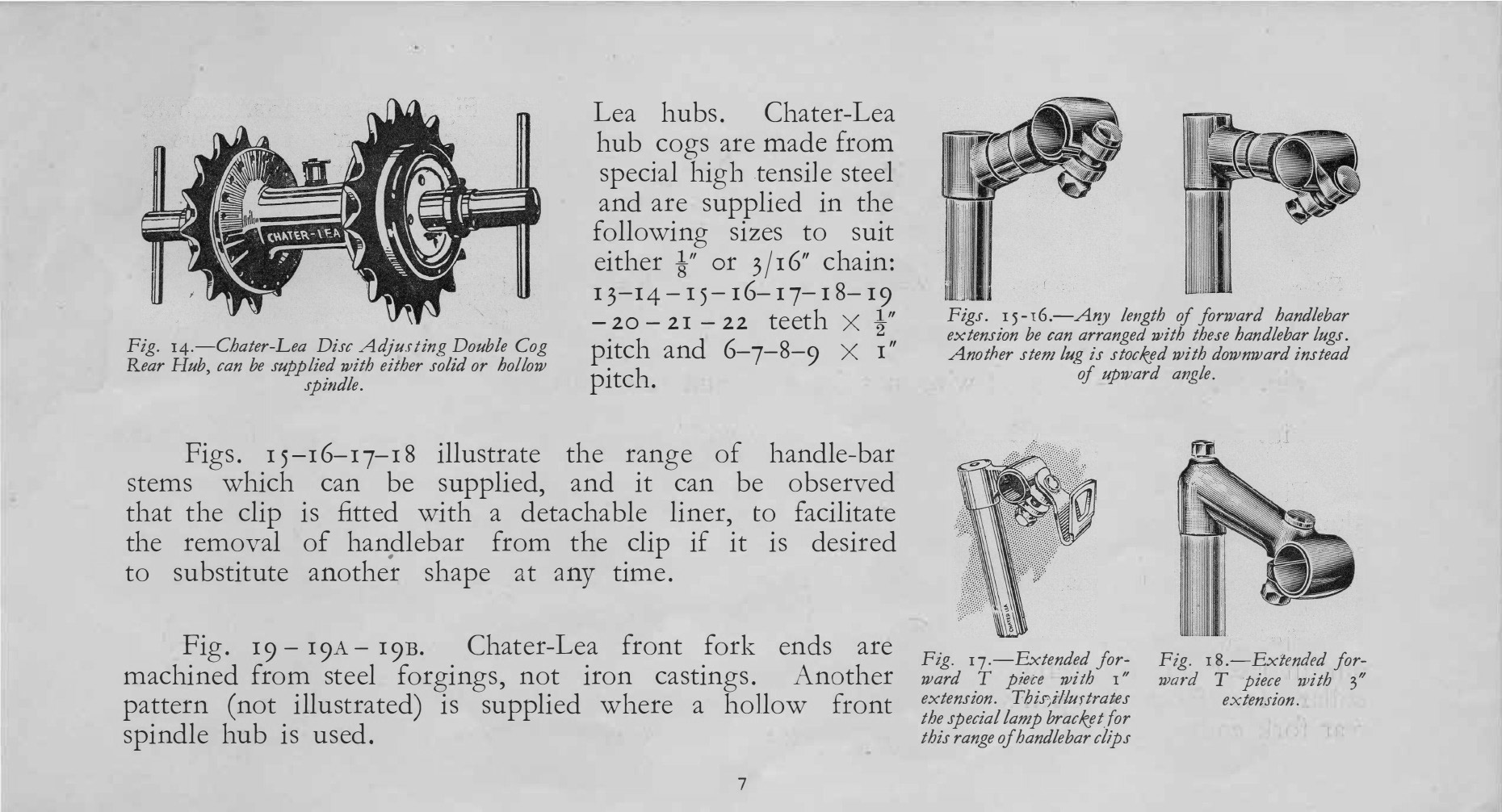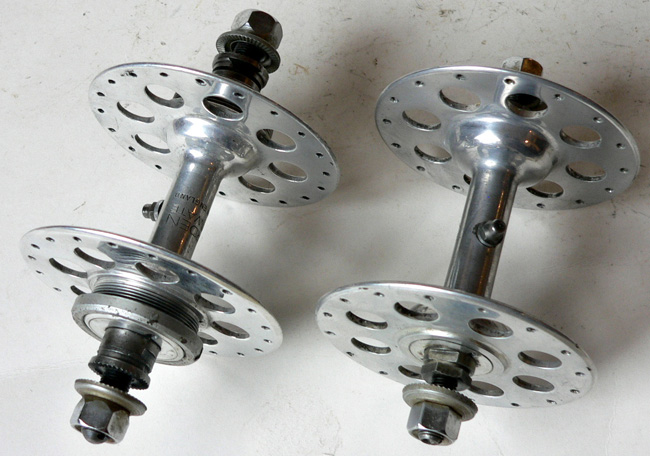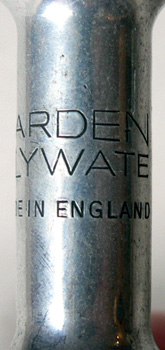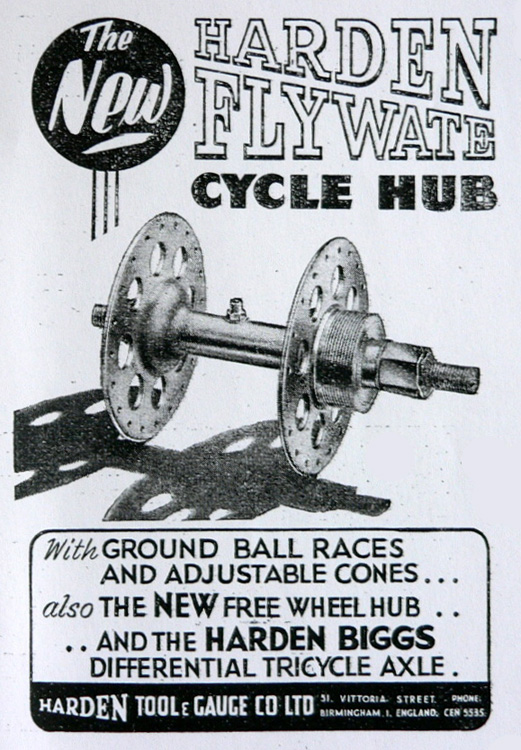Harden bicycle products
Posted: Thursday 11th June 2020
Harden hubs: instantly recognisable and certainly the most distinctive and innovative British hub design. Harden’s place in cycling history is assured by their use of cartridge bearings (caged non adjustable roller bearing) not just for their hubs but also for the bottom bracket. If that wasn’t enough in the late 1940s they produced a freehub 40 years ahead of Campagnolo and Shimano.
Mention of Harden hubs within the VCC seems to produce two very different reactions. Firstly, they are regarded as the greatest hubs ever produced, light years ahead of their time. An engineering marvel combining free running with an appearance aesthetically pleasing to the eye. The contrary view is that they were expensive compared to quality cup and cone hubs of the period (e.g. Airlite and Bayliss Wiley) with bearings prone to failure and difficult to replace – simply not up to the job. Stories of axles breakage, especially in track racing are then quoted.
The purpose of this article is to outline Hardens history by reference to period sources, drawing on more recent research (1) and recollections by a former employee David Goss (2).
The origins of Harden are to be found in the Jewellery Quarter in Birmingham in Vittoria Street. In the early 1930s one J. Kraut (a Swiss) a was a maker of clock gears and parts. He also had the contract to wind and maintain the municipal clocks. J. Kraut died in 1935 and shortly afterwards the family sold up and returned to Switzerland. The purchasers were a J. Hart and a Miss Eden (the company secretary and principal investor). It was a combination of their names that gave rise to the company name Harden.
J. Hart sent his son Harold to the USA to be educated and become an engineer. When he returned the company expanded, starting to manufacture jigs and tools for the then rapidly expanding aircraft industry. In 1945 the Harts sold the company to Cecil Jordan who had been factory manager at Hobson carburettors in Coventry.
David Goss upon whose recollections this article draws extensively joined Harden in 1936, initially as the family driver who duties included taking Harold’s children to school in a large American car. He then became an apprentice toolmaker and ended up as foreman during the period of cycle component production. At the time of his marriage in 1940 his best man was Don Humpage, a well-known Midlands track cyclist who was then Harden foreman.
That Harden ever made cycle components is very much down to the interest and motivation of one man Don Humpage. Post- war he became one of the directors During WWII Harden made specialist alloy parts for the aircraft industry (in particular anti-icing devices for the Halifax bomber) and it was this expertise that Humpage applied to bicycle hubs. In the latter part of the war he had a number of prototypes made up including a front hub of magnesium alloy, which still survives to this day on his Joe Cooke cycle, which is owned by a VCC member.
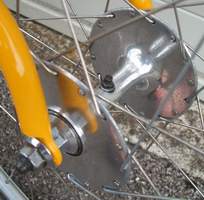
In 1945 Harden obtain a patent for the Humpage alloy hub design with cartridge bearings. Manufacture began at the end of that year. Initially all hubs were large flange and undrilled, a style that became known in Britain as ‘bacon slicers’ These were offered in versions typical for the time e.g. double or single fixed, gear /fixed and gear only. One problem with these hubs is that the spoke holes are drilled very close to the edge of the flange. This can result in the flanges cracking. This can be caused by a number of factors including spokes over tightened, a chain coming off the rear usually fixed sprocket or now simply the age of the metal (around 60 years old). With its elegant curve from flange to hub barrel and Tecalemit grease nipple they are certainly some of the most attractive hubs ever produced. In 1947 a drilled version appeared described by Harden as ‘with lightening holes’. Some of the drilled hubs clearly started off as bacon slicers as some lightening holes are drilled through the Harden logo. Further evidence that Harden supply out weighed demand.
There were also small flange hubs although these are far rarer, by a ratio I estimate of 1 to 40. These were produced when the sale of large flange tailed off in 1948 the idea being to compete with Bayliss-Wiley and Airlite. This failed, as they were significantly more expensive. They were produced by merely reducing the size of the flange and thus are identical in all other respects to the large flange hub. David Goss estimates Harden produced 100,000 large flange hubs and about half that number of the conventional cup and cone version (Flywate).
The only hubs exported were 500 cartridge large flange, in 1947 to Australia (to Bruce and Co). David records that they were extremely grateful for the food parcels received from the importer (remember this was the height of rationing some items not rationed in the war were now rationed!).
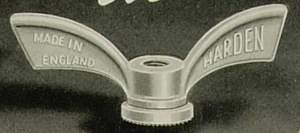
Harden also produced track nuts, some marked, some not, and from 1947 marked wing nuts. These were designed by a relative of the Jordans.
In 1948 they produced a cartridge unit bottom bracket (see image below) designed to fit in an undrilled bracket shell. There was serious design fault in that the axle tended to break on the drive side where it was a drilled for adjustment. This design was developed successfully by Stronglight who from the late 50s until the late 70s produced a very high quality (and expensive) needle roller bearing model in both cottered and cotterless versions.
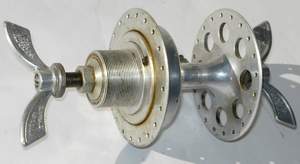
In 1949 Harden marketed a freehub of a very innovative design with the top gear sprocket screwed on and the rest splined on. The weight of the unit minus sprockets was 14 oz. It received a very positive test report in ‘Cycling’ being subject to the uses and abuses of a tandem tour in a mountainous region of France. Bearing in mind freehubs was not widely adopted until the late 1980s you quickly realise just how innovative this design was. Simplex and Bayliss Wiley had both produced freehubs in the late 1930s, but these were based around conventional bearings. Both the freehub and the bottom bracket were produced in very small qualities: according to David Goss around 35 of each. At the height of cycle component production they employed about sixty staff.
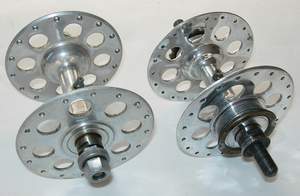
Also in 1949 they advertised the Flywate, a conventional cup and cone large flange hub. Some of these are not marked Harden but can be recognised by the fact they used the Tecalemit nipple and have the distinctive Harden profile.
Although these we cheaper than the annular bearing Hardens, they were still more expensive that competitors like Bayliss Wiley or Airlite and thus were not a commercial success. The switch to conventional bearings was made all the easier as David Goss’s sister-in-law was employed by a manufacturer of cup and cones.
Finally in 1949 they advertised their final cycle product, a differential tricycle axle: the Harden-Biggs. During the course of my research I have been unable to locate one. It is possible it never progressed beyond the prototype stage, although it is referred to in an advertisement in Cycling in that year.
Harden continued in the cycle trade until 1953 but there was no further innovation after 1949. Indeed David Goss suggests that they did not produce any hubs after 1950 merely selling existing stock. Their departure from the cycle business seems to have coincided with Don Humpage leaving to form a sub-contracting company, Beacon Tool Company. Also at this time there was the general decline in the lightweight cycle trade with the start of the car boom.
Not long after their introduction cyclist began to experience technical problems with the hubs. Considerable numbers were returned usually with bearing problems, which cyclist and dealers believed to be unrepairable. Harden advertised a special service for local racing cyclists: the opportunity to service your hubs by opening the factory on Saturday morning. For other cyclists they offered a 24-hour turnaround time. By 1951 this task had been given to outside contractors. By 1954 this service has ceased, Harden tried to fit stronger bearing, but to no avail.
Clearly there were problems but one wonders how much was caused by dealers and cyclists not understanding that it was possible to obtain replacement bearings and doing the job yourself. According to David Goss:
“We made more money [than selling hubs] setting up a repair service to replace the ball-race bearings which had a very short life due to them being overstressed for the job they were expected to fulfil”
Even Cycling magazine’s technical expert, ‘The Lightweight Man’ writing 25th May 1960 stated that the bearings were not available. He was put right by a reader R. E. Greenbury a couple of weeks later who pointed out this was a fallacy and that they were easily available industrial bearings (he quotes Hoffman S3 and Fischer EE3). They could be fitted by removing the locknuts and dust caps, warming the bearing housing and taping the end of the spindle until the old bearings dropped out. To refit fit new bearings while still warm and refit dust caps and locknuts.
I think there is a parallel with Cyclo and the uphill battle they had to introduce derailleur gears in Britain in the 30s. However unlike Harden, Cyclo issued very detail instructions to fitting servicing and repairing gears. Perhaps because of the money to be made in servicing, Harden deliberately refrained for issuing any maintenance instructions. Some of their adverts actually stated:
“never take your Harden hubs to pieces…simply lubricate occasionally with a grease gun”.
During my research I came across a classic example of cyclist ingenuity. A rider in Barrow in Furness who worked for the local bus company repairing ticket machines noticed that these used the same bearings as Harden hubs. He then had a very successful sideline in repairs with his local club.
Hardens were far more expensive that other quality hubs. In a 1948 Cycling Claud Butler offered a pair of Fiamme rims on Gnutti’s for £4 12s 6d, the same rims on Hardens were £7 8s 6d. To many club cyclists this must have been far too much to pay. One reason for the high price was that the hub polishers belonged to a very powerful trade union and were able to demand high rates.
Harden advertised extensively in the cycling press in the late 1940s and employed one rider Wally Summers to use their hubs.
Hub Details
Early Hardens can be identified as they are stamped ‘patent pending’ later ones have the patent number 596137 stamped on the flange.
The centre section diameter varies there seems to be two ranges:
a. 14.3mm to 14.6mm
b. 16mm to 16.6mm
This does not correspondence to manufacturing dates, as hubs known to be sold as pairs have both diameters. This inconsistency extends to the Flywate range. It is not always the rear hub, which is fatter. Some Flywates are not marked Harden . The first version of the Flywate uses smaller non-standard cones, the later ones use standard cones. According to David Goss the owners had a family connection with a maker of cup and cones.
There were two versions of the Flywate the earlier one having an identifical hub body to the cartridge bearing hubs. The later version has a double curve more like a Campagnolo hub.
Cage bearing fit was 875” x 312” x 281”
The locknut was originally one piece, but with a change in supplier became two with a separate washer this occurred around 1948.
Probably the most unique Harden hub is a rear with lightening holes on one side only; this was a Holdsworth rep sample designed to illustrate the two options in one hub. I have seen Hardens fitted with quick release axles, these are home made modifications.
In 1953 the company moved to South Wales to take advantage of government grants to encourage relocation to assist in employment of disabled Welsh miners. They became known as Harden Valve Company based in Ammanford and continued in business until the 1990s but ceased to have any connection with the cycle trade.
Servicing
See A guide by Peter Underwood
Summary
Harden hubs clearly have very special place in the history of lightweight parts. Thanks to the vision of one man, Don Haupage they produced some of the British cycle industries most technically innovative products. Throughout the last fifty years many high quality hubs have essentially refined Hardens design these include Maxicar, Mavic, Sachs and Phil Wood. Today all bottom brackets use sealed bearing, which are a direct descendant of the Harden design. Similarly the freebub and sealed bottom bracket are now pretty much ubitiquous, a classic example of a British designs being taken and developed by a Japanese company (Shimano).
You may be asking at this stage is the author of this piece pro or anti Harden? To give a politicians answer I think there is something to be said for both views. Yes they were innovative, smooth running and aesthetically pleasing but there were certainly technical issues. According to David Goss the main problem was the bearing were insufficient for the task. Harden fitted 7/8” x 3/8”x 7/32” when he thinks they should have used 1 1/8” x ½ x 9/32” . This would have made them even more expensive and heavier!
As long as VCC lightweight cyclists meet I am sure the debate will continue.
I believe that failures with small-caged bearings guided Hardens to move to conventional cup and cone bearings as used in their Flywate hubs.These came in two forms, images of the later version below. These double curvature versions would have been the very last Harden hubs made. I asked David Goss why there were two versions of the Flywate; the answer was simple and predictable. The first version, which is almost indistinguishable from the roller bearing Harden hub, used unique smaller cup and cones which Harden made themselves. The later versions used a standard cup and cone which they could buy in from a local company that specialised in making cups and cones for the cycle industry.
These very last double curvature Harden Flywate hubs are amongst the most attractive large flange hubs ever made by a British manufacturer. The copy of this 1950 Harden advert is towards the end of Harden hub production but very ample stocks abounded in shops and storerooms for years to come.
An observation that I have made before, the man who was responsible for stamping the makers trade- marks on hubs at the Harden hub factory ought to have been ‘fired’ for being incompetent . Very many Harden Flywate hubs left the Harden factory with no makers marks on at all…….nothing ! It has been with some difficulty that I have matched these two Flywates both with stampings …but note that they are not identical.
Posted: Thursday 11th June 2020
This article appears in the following categories.
Upcoming Events
Whether you are looking for a gentle social meet up, or a 100-mile ride browse the community’s upcoming events and plan your next weekend outing.
